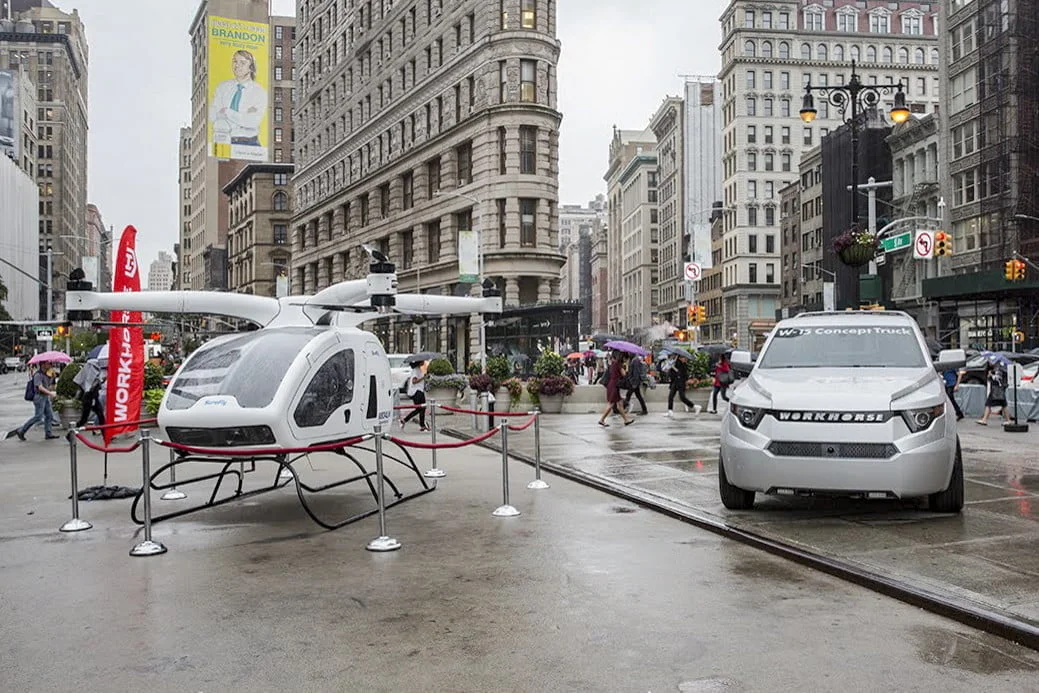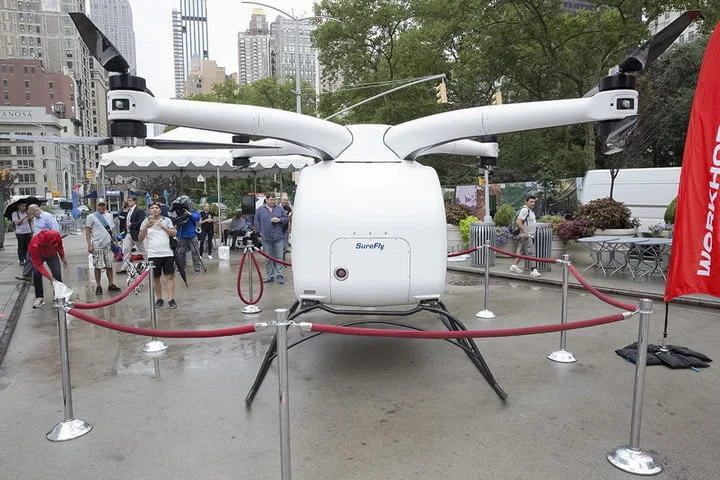From Drones to Pickup Trucks, Workhorse CEO Believes the Future is Electric.
Tesla isn’t the only company focusing on electric vehicles. But instead of luxury cars, Ohio-based Workhorse builds electric delivery vans, and it’s developing an extended-range electric pickup truck called the W-15. The company is also working on drone delivery, and a human-piloted aircraft called the SureFly that looks like a cross between a drone and a conventional helicopter.
Workhorse recently brought the W-15 and SureFly to New York City, where Digital Trends chatted with CEO Steve Burns about the company’s many projects.
DT: We have the SureFly octocopter and W-15 pickup truck here. Workhorse also builds electric vans and is developing delivery drones. How did you get into so many different projects?
Steve Burns: It all started innocently enough. We first went into electrification. We didn’t have the wherewithal to put fast-charging networks all across the planet. They [electric delivery vans] go a defined range, and they come back to the barn at night. That’s how we got into delivery vans.
Since we cater to people that deliver things, we said, “we’re essentially making a more efficient truck, but a person going door to door in a truck is as old as the hills,” right? We thought, “how can we refine that?” And then we thought a drone could help the driver be more efficient. If you have three deliveries to the right, and one to the left, give the one on the left to the drone.
The FAA has let us start doing some testing, and it’s clearly going to be dramatically more economical. We let the customer opt in. They download the app, say “I want drone delivery.” They touch on the screen where they want [the package] to be delivered, and it winches it down.
That’s where we learned to fly. Then, as we wanted to do more and more cargo, we got to the point where we said we might as well build a manned [aircraft]. The FAA has a limit of 55 pounds [of cargo] on a drone.
So that FAA limit was the impetus for the SureFly?
Right. If you put a pilot in it, a person in it, suddenly it’s not a drone and, if you can get the FAA to certify it, you can fly it anywhere just like a helicopter.
We’ve been flying under experimental certification for about six months. Now they’ve accepted our application for full-type certification. We’re going to go through that very rigorous thing to allow us to sell that in the United States.
How many more steps do you have to go through before being able to sell it?
There are a lot of steps. But time-wise, we’re hoping to get it done in two years. It could take longer. It’s difficult to know. It’s the first of its kind to go through the process.
You mentioned cargo as one application. What other applications are you looking at?
Since we’re kind of fleet-centric, we want to sell to fleets first. So, like a paramedic; it can probably get there faster than any ambulance. It doesn’t have the long wind-up of a helicopter; it can be running instantly.
What kind of other applications are we looking at? It could be a farmer doing precision agriculture. It could be a rancher checking on the cows. It could be military. But really, the number of calls we get, the biggest thing is people wanting to avoid traffic. So, in the end I think that’s going to be its biggest use, but we’ll start with fleets.
Why an octocopter, instead of a regular helicopter?
Our drones are octocopters. When we went to make something, we thought, “why doesn’t everybody have a helicopter in their garage?” It takes a long time to learn to fly a helicopter and be certified, they’re pretty costly to buy and maintain, and most people feel they’re not safe.
The first thought is, “is it safe?” It’s got eight propellers because if one should get hit with a bird, you can still get down. It’s got a generator that keeps the battery charged, but if the generator fails you’ve got enough battery to get down. And it’s got a parachute right in the middle of it. So [it has] a lot of redundancies.
You said you’re a fleet-centric company, so is the W-15 pickup going to be a fleet vehicle as well?
We made fleet delivery trucks, and then we thought, “what’s the number one fleet vehicle in the United States?” It’s a pickup truck. It’s the number one consumer vehicle, but it’s also the number one fleet vehicle.
Then we thought, “how could the number one vehicle not even have a mild hybrid?” They’re all just gas or diesel. Almost every SUV or sedan has at least a hybrid in the books, or maybe a full electric, but not pickup trucks. We started looking at it; we thought we had the chops to do it.
We thought, “well, let’s not make it just electric; let’s just try to make it the best pickup truck for fleets.”
For example, the hood is tapered downward. As opposed to normal pickup trucks, where grilles are getting larger and larger. That makes it difficult to see over; a lot of mayors are worried about hitting pedestrians with municipal vehicles. It also cuts through the wind better. But we didn’t take it down to a point, because we still wanted it to look like a pickup truck.
What was the thinking behind offering an extended-range electric powertrain?
Unlike a passenger car, a pickup truck can just double its weight. You just throw 3,000 pounds in the bed, or haul 6,000 pounds [on a trailer]. Whatever battery range you advertise, let’s say it’s 200 miles, it could go down to 100 miles if you’re towing something.
We’re coming out with two versions: an all-electric version, and a range-extended. All of the 6,000 preorders [we have] are for the range-extended.
If it’s really going to be successful, we didn’t want to say “okay, this gets 75 MPGe [miles per gallon equivalent]” but have an asterisk say it can’t do certain things. We wanted too take away the asterisk. Let’s try to make a vehicle that can do anything a diesel truck can do, but get 75 MPGe.
When will the W-15 go into production?
We’re trying to get people like Duke Energy, who bought the first 500 trucks, what’s called a manufacturer’s test vehicle late this year so they can start to test it. We want to get it into production in the first quarter of 2019.
As you said, pickup trucks are the biggest segment not just for fleet vehicles, but consumer vehicles. Is there any chance that the W-15 will be available to non-fleet buyers?
We’ve started to get a lot of calls for that. To test the market, we started taking preorders, [customers] put $1,000 down. We kind of took a page out of Tesla’s book there, to test the market. And it’s pretty robust.
What we’ve told all of them is, if you’re going to put your money down, first we’ve got to get through the initial wave of fleet orders. We really want to cut our teeth there before we go into full-blown consumer sales.
Click HERE to view the original article.







